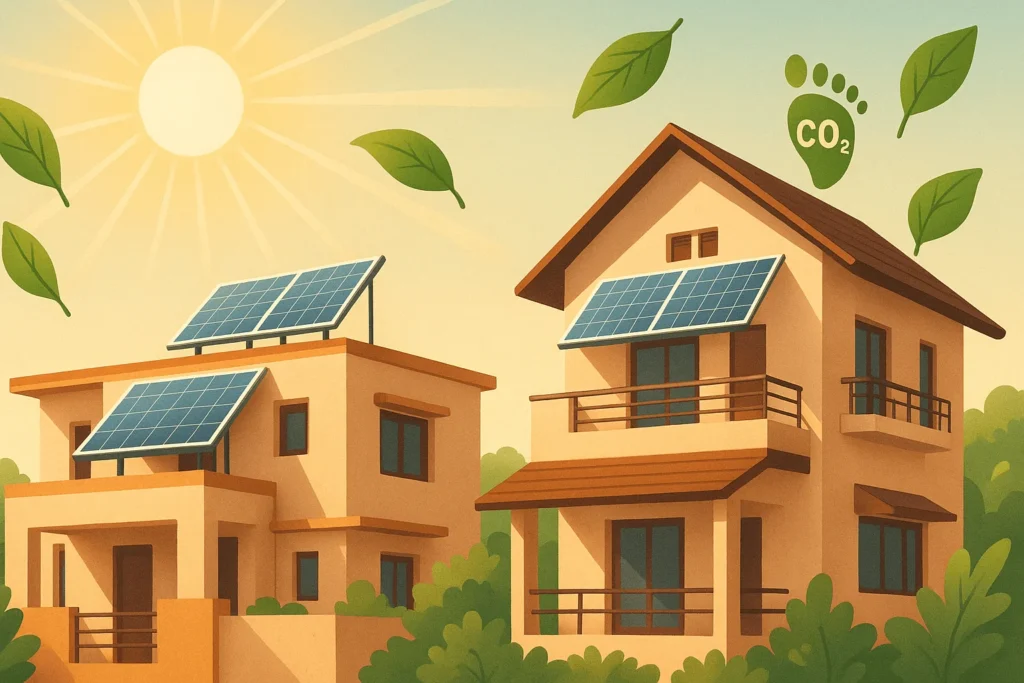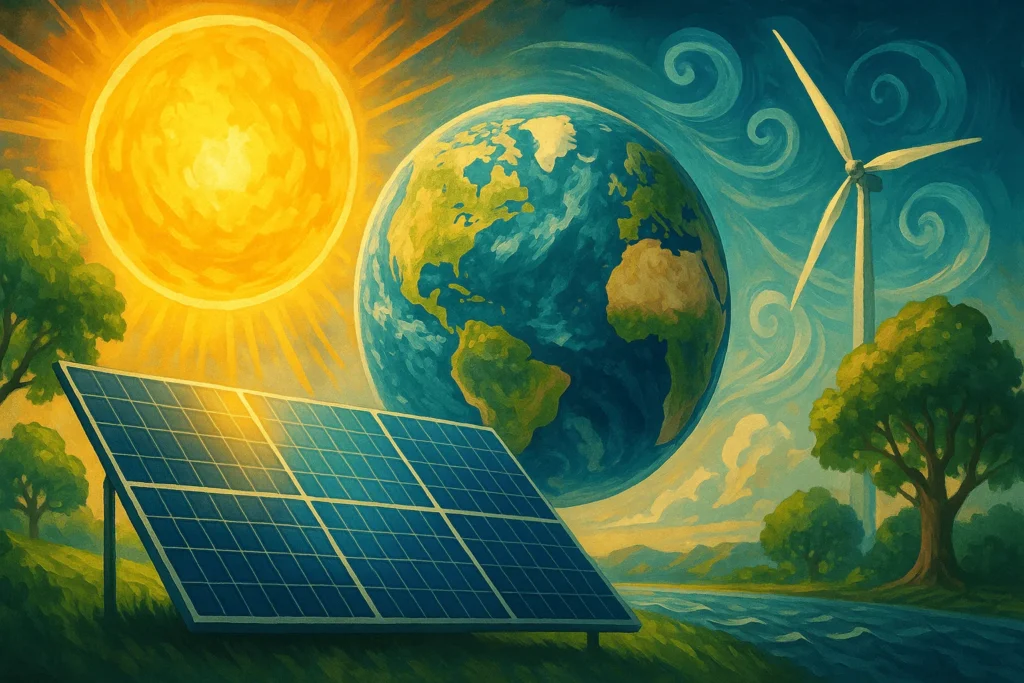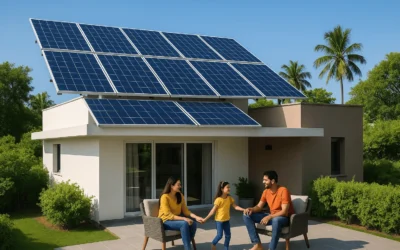In India, solar energy has evolved from an increasingly common phrase to an important option for households, companies, and even populations searching for more environmentally friendly and innovative methods of sustaining their daily lives. Considering there is sunlight almost all year round, becoming solar sounds like an appropriate next step. However, not everyone is aware of the environmental impact of solar energy, yet the majority of us know the money-saving and environmentally friendly advantages.
Let’s dive into a balanced look at the environmental impact of solar energy, what it gets right, what needs work, and why it’s still one of the best choices we can make today.
What Is Solar Energy and How Does It Work?
Basically, solar energy comes from sunlight, which is captured by solar panels (usually on rooftops or open land) and converted into electricity using photovoltaic (PV) technology.
You’ll mostly find three types of solar systems:
- Rooftop Panels: Common in homes, apartments, and office buildings.
- Ground-Mounted Systems: Installed on land around factories, schools, or farms.
- Solar Farms: Large-scale installations that generate electricity for cities and the grid.
India has sunlight for almost a year, then using the sunlight and converting it into solar energy, making it usable in a practical and cost-effective for long-term use.
Environmental Benefits of Solar Energy

1. It Cuts Down Greenhouse Gas Emissions
Unlike traditional power sources like coal or diesel, solar doesn’t burn any fuel. That means zero emissions during electricity generation. A typical home solar system in India can offset about 3 to 4 tonnes of CO₂ every year. Over time, that adds up to a major reduction in pollution.
2. Cleaner Air and No Water Wastage
Coal-based power plants release harmful pollutants into the air, contributing to smog, asthma, and other health problems. Solar panels, on the other hand, don’t emit anything.
Plus, solar energy doesn’t need water to operate, unlike thermal or nuclear plants. This is especially valuable in a country like India, where water scarcity is a growing concern.
3. Renewable, Reliable, and Sustainable
The sun isn’t going anywhere for the next few billion years. Solar energy is renewable, doesn’t run out, and can be accessed even in remote areas. As electricity demand grows, solar energy offers a clean and stable alternative that does not deplete natural resources.
4. It Helps Homes and Businesses Reduce Their Impact
When you switch to solar, you’re actively reducing your carbon footprint. Whether it’s a small apartment or a large factory, every solar panel installed reduces our dependence on polluting fuels. Plus, it gives people more control over their energy use.
Environmental Challenges of Solar Energy
Like all technologies, solar energy isn’t flawless. However, the key is to be aware of the issues so they can be tackled responsibly.
1. Manufacturing Has an Environmental Cost
Solar panels are made using materials like silicon, aluminum, and silver. Mining these materials and producing the panels requires energy and water. That said, once installed, solar panels produce clean energy for 25–30 years, making up for their initial footprint over time.
2. Large Solar Farms Can Disrupt Land Use
When solar farms are built on agricultural or ecologically sensitive land, they can disrupt local habitats or reduce usable farmland. Rooftop systems and unused land are better alternatives. Fortunately, India is starting to explore creative solutions like installing solar panels over canals or barren land.
3. End-of-Life Panel Waste Is a Growing Concern
At the end of their lifecycle, solar panels must be disposed of or recycled. Right now, India doesn’t have a well-developed recycling infrastructure for this, which could lead to waste issues in the future. The good news is that most parts of a solar panel, like glass and metal, can be recycled, and innovations in this space are already underway.
Innovations That Reduce the Environmental Impact of Solar Energy
Solar technology is evolving fast. Manufacturers and researchers are working on solutions to make solar even cleaner:
- Greener Manufacturing: Some companies now use renewable energy to power their factories and minimise chemical use.
- Panel Recycling: New recycling methods are being developed to recover valuable materials from old panels more efficiently.
- Smarter Designs: Panels today are more efficient and durable, which means fewer materials and less waste over time.
With government-backed schemes and subsidies, India has become a key player in clean energy growth. The Ministry of New and Renewable Energy (MNRE) regularly updates policies and programs to support both residential and commercial solar adoption.
At Daylight Solar Energy, we carefully work on the environmental impact of solar energy and select technology partners who prioritise sustainability, not just performance.
Why Solar Still Stands Out Among Energy Sources
Here’s a simple comparison of how solar stacks up against other common energy sources:
| Energy Source | Carbon Emissions | Water Usage | Waste Impact |
| Coal | Very High | High | Fly ash, CO₂ |
| Diesel | High | Low | Oil, CO₂ emissions |
| Nuclear | Low | High | Radioactive waste |
| Solar | Very Low | None | Mostly recyclable |
Even with a few imperfections, the environmental impact of solar energy remains significantly lower than fossil fuels.
The Way Forward with Solar Energy

Switching to solar is not just a smart financial move, it’s a long-term investment in a cleaner environment. Yes, there are challenges related to production and recycling, but the industry is aware and already moving toward better practices.
When installed thoughtfully and responsibly, solar energy can help India meet its growing energy needs without compromising the health of our planet.
At Daylight Solar Energy, we’re proud to help families and businesses make the switch with confidence, offering not just technology but trustworthy guidance every step of the way by making it positive environmental impact of solar energy.
Frequently Asked Questions (FAQs)
What is the environmental impact of solar energy?
Water use, air pollution, and carbon emissions are all reduced through solar energy. However, the production and disposal of panels have a negative influence on the environment.
Are solar panels environmentally harmful?
Not when in use. While there may be some effects from their manufacture and disposal, most materials are recyclable, and advancements are always being made.
How much CO2 can be avoided with solar power?
Over a 25-30 year period, a typical 3kW rooftop system may save approximately 3-4 tonnes of CO₂ year, which makes a significant impact.
Can solar panels be recycled?
Yes, most components, like glass and metal, can be recycled. India is still building up its solar recycling infrastructure.
What are the downsides of solar energy for the environment?
The key concerns include land use for large farms, energy use in manufacturing, and limited recycling facilities. These are being addressed with new policies and technologies.











0 Comments